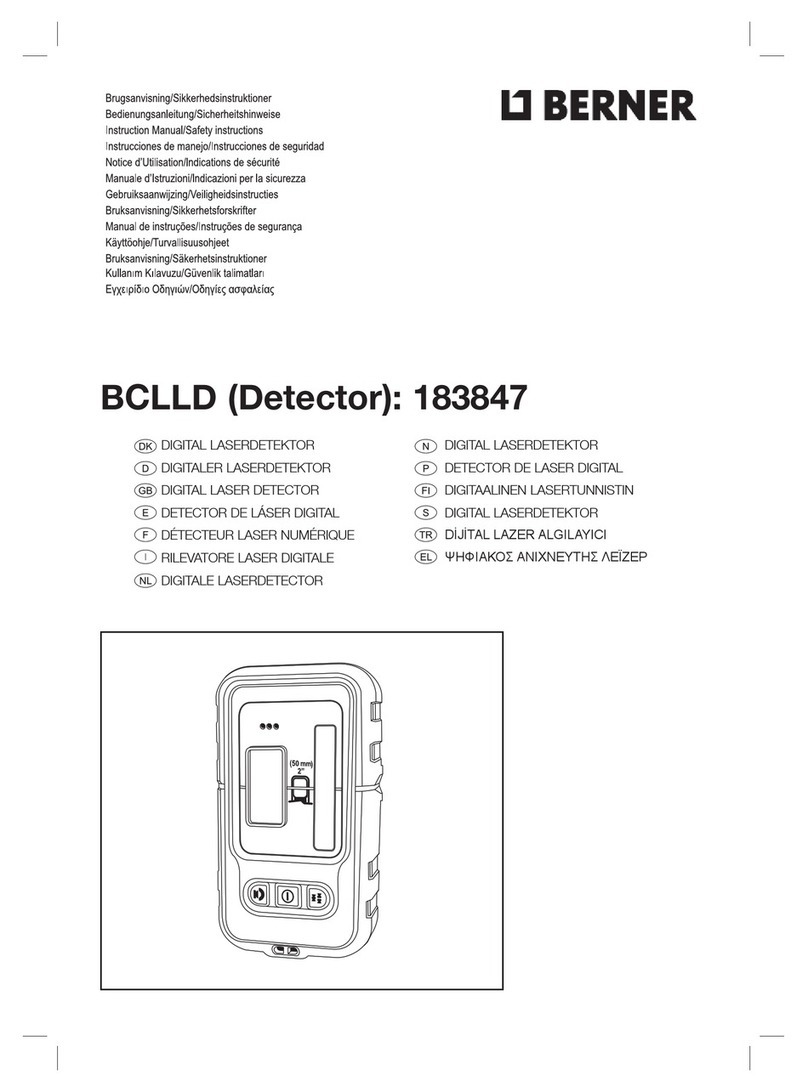
8| Deutsch 2 609 140 979 • 27.11.12
Wird ca. 5 min lang keine Taste am Messwerkzeug
gedrückt und werden keine Objekte detektiert,
dann schaltet sich das Messwerkzeug zur Scho-
nung der Batterie automatisch ab.
Displaybeleuchtung ein-/ausschalten
Mit der Taste Displaybeleuchtung 6können Sie die
Displaybeleuchtung ein- und ausschalten.
Signalton ein-/ausschalten
MitderTasteSignalton7könnenSiedenSignalton
ein- und ausschalten. Bei abgeschaltetem Signal-
ton erscheint im Display die Anzeige a.
Funktionsweise (siehe Bilder A–B)
Mit dem Messwerkzeug wird der Untergrund des
Sensorbereiches12inMessrichtungAbiszurmax.
Erfassungstiefe (siehe „Technische Daten“) über-
prüft. Erkannt werden Objekte, die sich vom Mate-
rial der Wand unterscheiden.
Bewegen Sie das Messwerkzeug stets geradlinig
mit leichtem Druck über den Untergrund, ohne es
abzuheben oder den Anpressdruck zu verändern.
Während der Messung müssen die Gleiter 11 im-
mer Kontakt zum Untergrund haben.
Messvorgang
Setzen Sie das Messwerkzeug auf die zu untersu-
chende Oberfläche auf und bewegen Sie es in
Richtung B. Nähert sich das Messwerkzeug einem
Objekt, dann nimmt der Ausschlag in der Messan-
zeige izu und der Ring 1 leuchtet gelb, entfernt es
sich von dem Objekt, dann nimmt der Ausschlag
ab. Über der Mitte eines Objektes zeigt die Mess-
anzeige iden maximalen Ausschlag; der Ring 1
leuchtetrotund es ertönt ein Signalton.Bei kleinen
oder tief liegenden Objekten kann der Ring 1wei-
terhin gelb leuchten und der Signalton ausbleiben.
fBreitere Objekte werden nicht in der gesam-
ten Breite durch den Leuchtring bzw. den Sig-
nalton angezeigt.
Um das Objekt genauer zu lokalisieren, bewegen
Sie das Messwerkzeug wiederholt (3x) über dem
Objekt hin und her. In allen Betriebsarten wird au-
tomatisch die Feinskala j aktiviert. Die Feinskala j
zeigt einen vollen Ausschlag, wenn das Objekt un-
ter der Sensormitte liegt oder der maximale Aus-
schlag der Messanzeige ierreicht wird. Zusätzlich
leuchtet in den Betriebsarten „Trockenbau“ und
„Metall“ noch die Anzeige „CENTER“ k.
Breitere Objekte im Untergrund sind durch einen
andauernden,hohenAusschlagder Messanzeigen
iund jerkennbar. Der Ring 1leuchtet gelb. Die
Dauer des hohen Ausschlags entspricht in etwa
der Objektbreite.
Werden sehr kleine oder tief liegende Objekte ge-
sucht und die Messanzeige ischlägt nur gering
aus, bewegen Sie das Messwerkzeug wiederholt
waagrecht und senkrecht über das Objekt. Achten
Sie auf den Ausschlag der Feinskala jund in den
Betriebsarten „Trockenbau“ und „Metall“ zusätz-
lich auf die Anzeige „CENTER“ k, die eine präzise
Ortung ermöglichen.
fBevor Sie in die Wand bohren, sägen oder frä-
sen, sollten Sie sich noch durch andere Infor-
mationsquellen vor Gefahren sichern. Da die
Messergebnisse durch Umgebungseinflüsse
oder die Wandbeschaffenheit beeinflusst wer-
den können, kann Gefahr bestehen, obwohl die
Anzeige kein Objekt im Sensorbereich anzeigt
(es ertönt kein Signalton und der Leuchtring 1
leuchtet grün).
Betriebsarten
Durch die Auswahl der Betriebsarten erzielen Sie
bestmögliche Messergebnisse. Die maximale Er-
fassungstiefe für Metallobjekte erreichen Sie in der
Betriebsart„Metall“.DiemaximaleErfassungstiefe
für spannungsführende Leitungen erreichen Sie in
der Betriebsart „Stromkabel“. Die gewählte Be-
triebsart ist jederzeit durch die grün leuchtende An-
zeige 4 zu erkennen.
Trockenbau
DieBetriebsart„Trockenbau“istgeeignet,umHolz-
und Metallobjekte in Trockenbauwänden zu finden.
Drücken Sie die Taste 10, um die Betriebsart „Tro-
ckenbau“ zu aktivieren. Die Anzeige 4 über der
Taste 10 leuchtet grün. Sobald Sie das Messwerk-
zeug auf den zu untersuchenden Untergrund auf-
setzen, leuchtet der Ring 1grün und signalisiert
Messbereitschaft.
In der Betriebsart „Trockenbau“ werden alle
Objektarten gefunden und angezeigt:
– nicht metallisch, z.B. Holzbalken
– magnetisch, z.B. Armierungseisen
– nicht magnetisch, aber metallisch,
z.B. Kupferrohr
– spannungsführend, z.B. Stromleitung
Hinweise: In der Betriebsart „Trockenbau“ wer-
den neben Holz- und Metallobjekten sowie span-
nungsführenden Leitungen auch andere Objekte,
z.B. wassergefüllte Kunststoffrohre, angezeigt. Im
Display 3 erscheint für diese Objekte die Anzeige c
für Nichtmetallobjekte.
Nägel und Schrauben im Untergrund können dazu
führen, dass ein Holzbalken im Display als Metall-
objekt angezeigt wird.
Zeigt das Display 3einen dauerhaften, hohen Aus-
schlag der Messanzeigen iund j, starten Sie den
Messvorgangneu,indem Sie das Messwerkzeugan
einer anderen Stelle auf den Untergrund aufsetzen.
Signalisiert der Leuchtring 1beim Aufsetzen auf
den zu untersuchenden Untergrund keine Messbe-
reitschaft, kann das Messwerkzeug den Unter-
grund nicht richtig erkennen.
– Drücken Sie so lange auf die Taste 10, bis der
Leuchtring grün leuchtet.





























